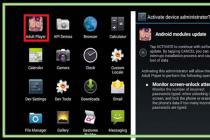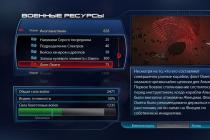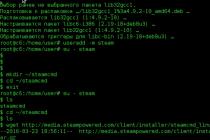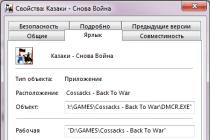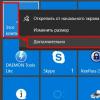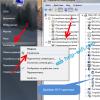AMD Radeon RX 480 8GB Review | Meet Polaris 10
Eight months ago, AMD began to unleash the power of next-generation GPUs, starting with an updated display controller that supports HDMI 2.0b and DisplayPort 1.3 HBR3, FreeSync over HDMI, and an HDR-compatible pipeline. Later, additional information began to appear, which talked about the release of two different GPUs, one of which was designed specifically for the mainstream desktop market, and the other for mobile solutions that offer console-level performance in thin and light form factors.
The second product includes 16 Compute Units (CU), 128-bit memory bus and accelerated 4K video encoding / decoding. It is not available yet. Video card AMD Radeon RX 480 uses the larger Polaris 10 processor design. It is no larger than an Nvidia GP100 processor with 15.3 billion transistors in terms of physical size, but it is capable of driving the best virtual reality headsets. In terms of performance, the card is on a par with the AMD Radeon R9 290 and Nvidia GeForce GTX 970.
The average level of performance of the card can hardly be called stunning, especially against the background of the new GPU Nvidia GP104. but AMD Radeon RX 480 it costs significantly less than solutions similar in speed, and power consumption is limited to 150 watts. Thus, AMD expects to make virtual reality available to a wider audience of gamers (it would be good if companies that sell HMDs for $ 800 and $ 600 would play along).
Two versions available AMD Radeon RX 480: $ 200 (MSRP) model with 4GB GDDR5 video memory at 7Gbps and $ 240 (MSRP) version with 8GB GDDR5 at 8Gbps. Today we are testing an 8GB model.
Features of Polaris 10
Polaris 10 consists of 5.7 billion transistors on a 230 mm2 chip. In comparison, a Hawaii crystal has 6.2 billion transistors and an area of 438 mm2. Despite fewer transistors and about 55% lower power consumption, the RX 480 sits between the R9 290 and 390 in most tests. This is largely due to the 14nm FinFET process from GlobalFoundries, which gives AMD significant performance and power advantages over AMD. planar transistors manufactured using the 28 nm process technology. FinFET provides a higher frequency at any level of power consumption, and vice versa, at any clock frequency, a chip with 14 nm consumes less power. In the case of Polaris, AMD took advantage of both by increasing clock speeds and lowering power consumption. So she managed to surpass the more powerful in terms of GPU resources Hawaii maintains a ceiling of 150 watts (although our measurements show that this figure is a bit understated).
Despite the new codename, the Polaris 10 is based on the 4th generation AMD Graphics Core Next architecture. Therefore, the building blocks of Polaris processor design will seem familiar to many enthusiasts, and it will be easier for us to describe it.
Specifications
| AMD Radeon RX 480 | AMD Radeon R9 390 | AMD Radeon R9 290 | |
| Polaris 10 | Grenada pro | Hawaii pro | |
| Computing Units (CU) | 36 | 40 | 40 |
| Stream Processors | 2304 | 2560 | 2560 |
| Clock frequency (base / Boost), MHz | 1120/1266 | 1000 | 947 |
| Peak computation rate, GFLOPs (at base frequency) | 5161 | 5120 | 4849 |
| Number of texture blocks | 144 | 160 | 160 |
| Speed up texture fill Gtex / s | 182,3 | 160 | 160 |
| Number of ROP units | 32 | 64 | 64 |
| L2 cache size, MB | 2 | 1 | 1 |
| Memory data transfer rate, Gb / s | 8 (8GB) / 7 (4GB) | 6 | 5 |
| Memory bandwidth, GB / s | 256 | 384 | 320 |
| Memory bus, bit | 256 | 512 | 512 |
| Thermal package, W | 150 | 275 | 250 |
| Number of transistors, billion | 5,7 | 6,2 | 6,2 |
| Crystal area, mm2 | 230 | 438 | 438 |
| Process technology, nm | 14 | 28 | 28 |
| starting price | $ 240 (8GB) / $ 200 (4GB) | $ 330 (8 GB) | $ 400 (4 GB) |
One GCP-Graphics Command Processor is still responsible for dispatching the sequence of graphics instructions to the Shader Engine. Asynchronous Compute Engine (ACE) takes care of the sequence of computational instructions. Only instead of eight ACEs, the command execution logic now consists of four ACEs and two Hardware Schedulers that perform the tasks of prioritizing queues, managing temporal / spatial resources, and offloading scheduling tasks for the CPU kernel-mode driver. In essence, these are not separate or new blocks, but rather an additional mode in which existing pipelines can operate. Dave Nalasco, AMD's senior manager of graphics workflows, made the following comment:
"Hardware Workgroup / Wavefront Schedulers (HWS) are essentially ACE pipelines without dispatch controllers. Their job is to offload the CPU by controlling the scheduling process for user / driver-defined queues on the available hardware queue slots. These are programmable processors with microcode that can different scheduling policies applied. We used them to implement Quick Response Queue and CU Reservation. We've also been able to port these changes to 3rd generation GCN graphics cards through driver updates. "
The Quick Response Queues feature allows developers to prioritize certain tasks that run asynchronously without completely preempting other processes. A more detailed explanation can be found on Dave's blog(English). In short, AMD wants flexibility. Its architecture allows for different approaches to optimize resource utilization and minimize rendering latency, both of which are extremely important for VR applications.

The well-known CU computational units consist of 64 shader units, compliant with the IEEE 754-2008 standard, divided into four vector units, a scalar unit, and 16 texture sample loading / storage units. In addition, each CU includes four texturing units, 16KB L1 cache, 64KB of local space for data exchange, and register space for vector and scalar units. AMD claims to have made many adjustments to improve CU efficiency, including adding support for FP16 (and Int16), optimizing cache access, and improving instruction lookahead. Taken together, these changes deliver up to 15% better CU performance over Hawaii GPUs (2nd Gen GCN).

Nine CUs form a large shader unit (SE - Shader Engine). The Polaris 10 video chip has four such SEs and we know that this is the maximum for this architecture. In total, we get 2304 stream processors and 144 texture units (64 shaders x 9 CU x 4 SE).

Each shader unit is associated with a geometry unit (GE - Geometry Engine). According to AMD, a primitive discard accelerator has been added to the geometry block, it filters out the simplest geometric elements that are not rasterized into a pixel before scanning transformation, thus increasing the throughput. This is an automatic feature of the pre-rasterization stage of the graphics pipeline and is new to Polaris. In addition, an index cache for cloned geometry has appeared, although we do not know its size and the degree of influence during cloning.
By analogy with the Hawaii video chip, the Polaris 10 processor is capable of rendering four simple elements per cycle. However, compared to Hawaii / Grenada GPUs up to 1050 MHz (in the case of the R9 390X), AMD has raised the base clock AMD Radeon RX 480 up to 1120 MHz, and the frequency in Boost mode is up to 1266 MHz. It turns out that the company compensates for the loss of resources on the crystal increased frequency... The single precision floating point performance of the Radeon R9 290X is 5.6 TFLOPS, while the RX 480 reaches 5.8 TFLOPS in Boost mode.
How realistic is the 1266 MHz clock speed? The Hawaii GPU had a hard time keeping up with the specs as it got very hot, and we wanted to make sure that didn't happen with Polaris. Using GPU-Z, we took readings clock frequency in the integrated benchmark of the Metro: Last Light Redux game, repeated 10 times in a row, and received the following graph:

Stress Test Clock - Built-in Metro: Last Light Redux Benchmark, 10 passes, MHz
The difference between the upper (1265 MHz) and lower (1118 MHz) points on the graph is 148 MHz. We can say that AMD fits well into the indicated limits, although the frequency is constantly being adjusted during the test. But at least the 1208 MHz average is closer to the top.
The Hawaii and Fiji SE GPUs each have four rendering backends capable of outputting 16 pixels per clock (64 pixels per clock in total). The Polaris 10 has cut this component in half. Each SE has two render backends, each with four ROPs, which collectively render 32 pixels per clock. The difference with the Hawaii-based Radeon R9 290 is quite significant. The situation is aggravated by the 256-bit memory bus Polaris 10, which is twice as narrow as the memory bus of the Hawaii video chip (512-bit). Version AMD Radeon RX 480 The 4GB uses 7Gbps GDDR5 memory and has 224GB / s bandwidth, while the 8GB model we are testing today uses 8Gbps memory and bandwidth increased to 256 GB / s. But in any case, this is much less than the 320 GB / in the R9 290.

The reduction in hardware resources is partially offset by improved delta color compression, which reduces the amount of information transmitted over the bus. AMD also supports lossless 2/4/8: 1 compression, just like Nvidia's Pascal architecture. In addition, the Polaris 10 uses a 2MB L2 cache, the same size used by Fiji. This will reduce the number of calls to the GDDR5 memory and further reduce the dependence of the GPU on the wide bus and high speed data transmission.
However, the depletion of the GPU backend should affect performance as the resolution and intensity of anti-aliasing increases. We wondered how the Polaris would look against the Hawaii as the intensity increased. To test this, we ran the Grand Theft Auto V benchmark at a modest 1920x1080 resolution with "Very High" graphics detail settings and gradually increased the anti-aliasing quality.

The graph clearly shows that when the MSAA anti-aliasing is changed from 2x to 4x AMD Radeon RX 480 loses average frame rate noticeably faster than R9 390. With anti-aliasing disabled, RX 480 reaches 97.3 FPS, and R9 390 - 90.4 FPS. But towards the end of the graph AMD Radeon RX 480 showed only 57.5 frames per second, while the 390th averaged 62.9 frames per second.
AMD Radeon RX 480 8GB Review | Display Controller, UVD, VCE & WattMan
New display controller
We've already covered some of the Polaris display controller improvements in this article. "Plans for the functional development of GPU AMD in 2016"... But it was published almost seven months ago.
At the time, we knew that Polaris would support DisplayPort 1.3 with High Bit Rate 3, using existing cables and connectors to deliver up to 32.4 Gbps over four lanes. The controller specification now includes the DisplayPort 1.4-HDR standard. It does not increase the bit rate, but it includes Display Stream Compression 1.2 technology to deliver 10-bit 4K content at 96Hz refresh rate. Also, the DisplayPort 1.4 standard supports the color space.
In the short term, AMD is still looking at DP 1.3 as a tool for implementing FreeSync in 4K. According to the company, panels with a refresh rate of 120 Hz will be available by the end of 2016, but in order to achieve good performance with high graphics settings in this configuration, the possibilities AMD Radeon RX 480 will not be enough. At the same time, the Vega processor design with HBM2 support will not officially appear until 2017.

We discussed HDR support in Polaris late last year, but AMD reiterates that the display pipeline is ready for the first generation of 10-bit HDR displays, and 12-bit HDR displays in the future. An easy-to-program color processing block includes gamma remapping, gamma control, floating point processing, and 1: 1 projection with any display.
Video encoding / decoding acceleration
During its heyday, ATI was renowned for its performance and quality video decode acceleration systems that shifted video playback tasks from the central processor to a combination of programmable shaders and fixed function blocks installed in the GPU.
We do not have details on where the Polaris decoder completes its tasks, but it is known that it is based on the UVD decoder and appears to have fixed functionality. AMD specifies in the specs to have HEVC decoding up to 4K60 using the Main 10 profile, which supports 10-bit 4: 2: 0 (all of which are required for HDR to work). There is hardware support for VP9 decoding, although AMD drivers have not yet implemented it, we only know that the feature is planned in a future update. If AMD wants to implement HEVC 10-bit / 4: 2: 0 color subsampling with HDR, at least Profile 2 compatibility is required. Hardware acceleration is also provided. M-JPEG format in modes up to 4K30.
The evolution of the AMD Video Encoder (VCE - Video Coding Engine) is also not well documented. Polaris is known to be able to encode HEVC 8-bit video up to 4K60, but GPUs based on GCN 1.2 architecture have the same equipment. It looks like AMD is working on expanding the list of VCE-compatible applications. Of course, the proprietary Gaming Evolved client is supported. But apart from that, the lists include Open Broadcaster Software, which previously only supported QuickSync and NVEnc. There is also Plays.tv - social network from the company in charge of the Gaming Evolved client.
At the end of June this year, AMD announced a line of new Polaris 10 and Polaris 11 GPUs, which are based on the most advanced 14nm FinFET process technology. At the moment, among the video cards released on the new graphics processors, there are three models: AMD Radeon RX 480, AMD Radeon RX 470 and AMD Radeon RX 460. In today's article we will conduct a brief overview of the reference model of the older video card and its comprehensive testing.Since all the theoretical calculations about the architecture of the new Polaris GPUs have long been published by other resources, today we will not touch on this topic. Just briefly note that the main innovations in the updated architecture of the fourth generation Graphics Core Next concerned improved processing of geometry and blocks of encoding and decoding video data, support for asynchronous computations in DirectX 12, support API Vulkan, more efficient compression methods, better energy efficiency, support for DisplayPort 1.4-HDR and HDMI 2.0b video outputs, and more.
1. Review of the AMD Radeon RX 480 8 GB video card
technical characteristics and recommended costThe technical characteristics and cost of the AMD Radeon RX 480 video card are shown in the table in comparison with the reference AMD Radeon R9 390, Radeon R9 380X and NVIDIA GeForce GTX 1060.

* - according to Yandex.Market data as of 09/15/2016.
design and features printed circuit board
The AMD Radeon RX 480 reference design is virtually indistinguishable from the design of the Radeon R9 Fury X and Nano, presenting a simple yet stylish 244 x 102 x 38mm graphics card. The entire front side is covered with a plastic casing with a structure of small round cells, and a large RADEON inscription is stamped on the left.


It is also visible in the upper part of the casing.

Combined with a similarly styled fan rotor, the reference Radeon RX 480's design looks complete and austere.


The video output panel has three DisplayPort version 1.4 and one HDMI version 2.0b.

As you can see, most of this panel is occupied by a grille for the unobstructed passage of heated air outside the case of the system unit. And the video card heats up very much, it should be noted.
To power the Radeon RX 480, there is one six-pin connector located at the top of the casing. The declared power consumption level of the video card is 150 watts, and for a system with one such video card, a 500-watt power supply is recommended. The power section of the printed circuit board is made according to a seven-phase scheme, where six phases are allocated to power the graphics processor and one to the video memory.
The new 14nm Polaris 10 XT GPU contains around 5.7 billion transistors and contains 2,304 unified shaders, 144 texture units and 32 raster operations (ROPs).

The frequency of the GPU in 3D mode should vary in the range from 1120 to 1266 MHz, but in practice it was far from always the case, which we will discuss below.
The Radeon RX 480 can be equipped with either 4 GB ($ 199) or 8 GB ($ 229) of video memory. Our copy of the video card had 8 GB of DDR5 memory with Samsung chips (according to GPU-Z).

The effective frequency of the video memory is 8000 MHz, which with a 256-bit bus can provide a bandwidth of 256 GB / s. This is immediately 33% higher than the main competitor NVIDIA GeForce GTX 1060 with its 192-bit bus (192.2 GB / s).
cooling system
From a practical point of view, it makes no sense to evaluate the efficiency of the standard cooler of the reference version of AMD Radeon RX 480, since by now the original versions with branded coolers have appeared on the market. But since they have not reached us yet, there is no choice, so today we will test the standard cooler, which is a combination of an aluminum radiator with a copper base for the GPU, a metal heat-distributor plate for power circuits and a turbine that pumps air through the radiator.

The entire system is covered with a plastic casing that directs the air heated by the video card to the panel with video outputs and a grill. The turbine speed is regulated by PWM in the range from 1200 to 4960 rpm.
We used nineteen cycles of the 3DMark stress test to test the temperature conditions of the video card as a load.

Since we did not yet have an updated version of MSI Afterburner at the time of writing this article, the GPU-Z utility version 1.9.0 was used to monitor temperatures. All tests were carried out in a closed case of the system unit, the configuration of which you can see in the next section of the article, at an average room temperature 25 degrees Celcius.
First, we checked the temperature mode of the video card with fully automatic fan speed control.

Automatic mode (1200 ~ 2450 rpm)
The temperatures are very high, it is obvious that the stock cooler, even having overclocked to 2450 rpm, is simply not suitable for ensuring the operation of the Radeon RX 480 on the standard maximum frequency 1266 MHz, because during testing it dropped down to 1000 MHz, and on average "floated" around 1050-1070 MHz.
At the maximum possible fan speed of the cooler, the peak temperature of the processor is 12 degrees Celsius lower, due to which the GPU frequency does not jump as much as with automatic adjustment.

Maximum speed (~ 4960 rpm)
Remarkably, the percentage of stability of the video card in the 3DMark stress test also increased from 87.6% to 97.8%.

Therefore, we can conclude that to ensure stable operation of the Radeon RX 480 and maintain the frequency of its GPU at high level(and hence performance) it needs efficient cooling like never before, despite the new 14nm process technology.
As for overclocking, for obvious reasons we did not study it on the reference video card. Let's hope that the original Radeon RX 480 models will allow us to fully disclose this issue and get acquainted with AMD's proprietary WattMan technology, implemented simultaneously with the appearance of the Radeon RX 480.

2. Test configuration, tools and testing methodology
Performance testing of video cards was carried out in a closed case on a system with the following configuration:
motherboard: ASUS Sabertooth X79 (Intel X79 Express, LGA2011, BIOS 4801 dated 07/28/2014);
CPU: Intel Core i7-3970X Extreme Edition 3.5 / 4.0 GHz(Sandy Bridge-E, C2, 1.1 V, 6 x 256 KB L2, 15 MB L3);
CPU cooling system: ARCTIC Liquid Freezer 240 (4 x 1100 rpm);
thermal interface: ARCTIC MX-4;
video cards:
Inno3D iChill GF GTX 980 Ultra HerculeZ X4 Air Boss 4 GB 1266-1367 / 7200 MHz;
Sapphire NITRO R9 390 OC Tri-X 8 GB 1040/6000 MHz;
NVIDIA GeForce GTX 1060 Founders Edition 6 GB 1506-1708 (1886) / 8008 MHz;
AMD Radeon RX 480 8 GB 1120-1266 / 8000 MHz;
ASUS GeForce GTX 970 DC Mini 4 GB 1050-1178 / 7012 MHz (GTX970-DCMOC-4GD5);
ASUS STRIX R9 380X Gaming 4 GB 1030/5700 MHz;
RAM: DDR3 4 x 8 GB G.SKILL TridentX F3-2133C9Q-32GTX(X.M.P. 2133 MHz, 9-11-11-31, 1.6 V);
system and game disk: Intel SSD 730 480GB (SATA-III, BIOS vL2010400);
disk for storing programs and games: Western Digital VelociRaptor (SATA-II, 300 GB, 10,000 rpm, 16 MB, NCQ);
archive disk: Samsung Ecogreen F4 HD204UI (SATA-II, 2 TB, 5400 rpm, 32 MB, NCQ);
sound card: Auzen X-Fi HomeTheater HD;
case: Thermaltake Core X71 (four be quiet! Silent Wings 2 (BL063) at 900 rpm);
control and monitoring panel: Zalman ZM-MFC3;
PSU: Corsair AX1500i Digital ATX (1500W, 80 Plus Titanium), 140mm fan.
monitor: 27-inch Samsung S27A850D (DVI, 2560 x 1440, 60 Hz).
As top benchmarks for AMD Radeon RX 480 performance, we included NVIDIA's original Inno3D iChill GF GTX 980 Ultra HerculeZ X4 Air Boss and AMD's original Sapphire NITRO R9 390 OC Tri-X in our benchmarks.




The direct competitor to the heroine of today's testing will be NVIDIA GeForce GTX 1060, which is represented by the reference version of the Founders Edition. Next to it in the photo is the ASUS STRIX R9 380X Gaming, which, following the marking of video cards in the AMD line, is being replaced by the new Radeon RX 480.




And finally, the fifth video card in testing is the ASUS GeForce GTX 970 DC Mini, which, oddly enough, today is barely cheaper than the Radeon RX 480, which means it can also hypothetically compete with it.


Let's add that the Power Limit value on all video cards was set to the maximum.
To reduce the dependence of the performance of video cards on the platform speed, a 32-nm six-core processor with a multiplier of 48, a reference frequency of 100 MHz and the Load-Line Calibration function activated at the Ultra High level was overclocked to 4.8 GHz when the voltage rises in the BIOS motherboard up to 1.385 V.

Hyper-Threading Technology is activated. At the same time, 32 gigabytes random access memory operated at a frequency of 2.133 GHz with timings 9-11-11-20_CR1 at a voltage of 1.6125 V.
Testing, which began on Aug 8, 2016, was conducted under the control of the operating room. Microsoft systems Windows 10 Professional with all updates as of the specified date and with the installation of the following drivers:
motherboard chipset Intel Chipset Drivers - 10.1.1.27 WHQL from 06.07.2016;
Intel Management Engine Interface (MEI) - 11.5.0.1019 WHQL from 08/09/2016;
drivers for video cards on graphics processors NVIDIA - GeForce 369.05 WHQL from 04/08/2016;
graphics card drivers AMD processors – AMD Radeon Software Crimson 16.8.1 WHQL from 08/07/2016.
The performance of the graphics cards was tested at resolutions of 1920 x 1080 and 2560 x 1440 pixels. Two graphics quality modes were used for the tests: Quality + AF16x - texture quality in the drivers by default with anisotropic filtering at 16x and Quality + AF16x + MSAA 4x (8x) with anisotropic filtering at 16x and full-screen anti-aliasing at 4x or 8x, in cases when average frames per second remained high enough for comfortable gaming. In some games, due to the specifics of their game engines, other anti-aliasing algorithms were used, which will be indicated later in the methodology and in the diagrams. Anisotropic filtering and full-screen anti-aliasing was enabled directly in the game settings. If these settings were absent in games, then the parameters were changed in the control panel of the Crimson or GeForce drivers. V-Sync was also forcibly disabled there. Apart from the above, no additional changes were made to the driver settings.
The video cards were tested in one semi-synthetic graphic test and in fifteen games, updated to the latest versions as of the date of the start of preparation of the material. The list of test applications is as follows (games and further test results in them are arranged in the order of their official release):
3DMark(DirectX 9/11/12) - version 2.1.2852, tested in Fire Strike, Fire Strike Extreme, Fire Strike Ultra and Time Spy scenes;
Crysis 3(DirectX 11) - version 1.3.0.0, all graphics quality settings to maximum, the degree of blur is medium, glare is on, modes with FXAA and with MSAA 4x, double sequential pass of a scripted scene from the beginning of the Swamp mission lasting 105 seconds;
Metro: Last Light(DirectX 11) - version 1.0.0.15, the built-in game test, graphics quality settings and tessellation at the Very High level, Advanced PhysX technology in two test modes, tests with SSAA and without anti-aliasing, double sequential D6 scene run were used;
Company of Heroes 2(DirectX 11) - version 4.0.0.21543, double sequential run of the test built into the game with the maximum settings for graphics quality and physical effects;
Battlefield 4(DirectX 11) - version 1.2.0.1, all graphics quality settings on Ultra, double sequential run of the scripted scene from the beginning of the TASHGAR mission lasting 110 seconds (for video cards based on AMD GPUs, the Mantle API was used);
Thief(DirectX 11) - version 1.7 build 4158.21, graphics quality settings to the maximum level, Paralax Occlusion Mapping and Tessellation technologies are activated, a double sequential run of the benchmark built into the game (API Mantle was used for video cards based on AMD GPUs);
Sniper elite iii(DirectX 11) - version 1.15a, quality settings at Ultra, V-Sync disabled, tessellation and all effects enabled, tests with SSAA 4x and without anti-aliasing, double sequential run of the benchmark built into the game (for video cards based on AMD GPUs API Mantle was used );
(DirectX 11) - build 1951.27, all quality settings are manually set to the maximum and Ultra levels, tessellation and depth of field are activated, at least two consecutive runs of the benchmark built into the game;
Grand theft auto v(DirectX 11) - build 757.4, quality settings at the Very High level, ignoring the proposed restrictions enabled, V-Sync disabled, FXAA enabled, NVIDIA TXAA disabled, MSAA for reflections disabled, NVIDIA / AMD soft shadows;
DiRT Rally(DirectX 11) - version 1.2, we used the built-in test on the Okutama track, graphics quality settings to the maximum level for all points, Advanced Blending - On; tests with MSAA 8x and without anti-aliasing;
Batman: arkham knight(DirectX 11) - version 1.6.2.0, quality settings at High, Texture Resolutioin normal, Anti-Aliasing on, V-Sync disabled, tests in two modes - with and without activation of the last two NVIDIA GameWorks options, dual sequential run of the built-in into a dough game;
(DirectX 11) - version 3.1, texture quality settings at the Very High level, Texture Filtering - Anisotropic 16X, and other maximum quality settings, tests with MSAA 4x and without anti-aliasing, double sequential run of the test built into the game.
Rise of the Tomb Raider(DirectX 12) - version 1.0 build 668.1_64, all parameters at the Very High level, Dynamic Foliage - High, Ambient Occlusion - HBAO +, tessellation and other quality improvement techniques are activated, two test cycles of the built-in benchmark (Geothermal Valley scene) without anti-aliasing and with SSAA 4.0 activation;
Far cry primal(DirectX 11) - version 1.3.3, maximum quality level, textures high resolution, volumetric fog and shadows to the maximum, built-in performance test without anti-aliasing and with SMAA activation;
Tom clancy's the division(DirectX 11) - version 1.3, maximum quality level, all picture enhancement parameters are activated, Temporal AA - Supersampling, testing modes without anti-aliasing and with activation of SMAA 1X Ultra, built-in performance test, but fixing FRAPS results;
Hitman(DirectX 12) - version 1.2.2, built-in test with graphics quality settings at the Ultra level, SSAO enabled, shadow quality Ultra, memory protection disabled.
If the games implemented the ability to fix the minimum number of frames per second, then it was also reflected in the diagrams. Each test was carried out twice, the best of the two obtained values was taken as the final result, but only if the difference between them did not exceed 1%. If the deviations of the test runs exceeded 1%, then the testing was repeated at least one more time in order to obtain a reliable result.
3. Results of performance tests and their analysis
On the diagrams, the test results for video cards on NVIDIA GPUs are highlighted in green, and on AMD GPUs they are reflected in the usual red color scheme for this manufacturer. To highlight the performance of the Radeon RX 480, we chose a dark red fill color. Let's add that on the diagrams in each quality mode, the test results are sorted from top to bottom in descending order of the cost of video cards.3DMark

In almost all 3DMark test scenes, the performance of video cards confirms their cost, clearly placing the products from top to bottom. Only in the Time Spy test the density of the results is higher. AMD Radeon RX 480 is at the level of ASUS GeForce GTX 970, slightly lagging behind its direct competitor NVIDIA GeForce GTX 1060 and noticeably ahead of ASUS STRIX R9 380X Gaming. Obviously, the performance of the Sapphire NITRO R9 390 OC Tri-X is beyond the reach of the heroine of today's article even when overclocked.
Crysis 3
Crysis 3 showed us a different picture.

Here AMD Radeon RX 480 does not look so confident anymore, yielding even to ASUS GeForce GTX 970 from the past NVIDIA lineup. The advantage of the new item over the ASUS STRIX R9 380X Gaming is not at all impressive, and the difference with the Sapphire NITRO R9 390 OC Tri-X is too great. Unfortunately, there can be no question of any struggle with NVIDIA GeForce GTX 1060.
Metro: Last Light
Recall that the game Metro: Last Light we tested as with Activation Advanced PhysX, and without it.


However, disabling Advanced PhysX did not help at all for AMD video cards today - the competitors turned out to be much stronger. The advantage of AMD Radeon RX 480 over ASUS STRIX R9 380X Gaming here ranges from 16 to 28%, and the backlog from Sapphire NITRO R9 390 OC Tri-X is from 2 to 24%.
Company of Heroes 2
In Company of Heroes 2, the alignment of forces does not differ much from Metro: Last Light - video cards based on AMD GPUs are inferior to their competitors based on NVIDIA chips.

AMD Radeon RX 480 is losing even ASUS GeForce GTX 970 here, what can we say about NVIDIA GeForce GTX 1060, which, in turn, successfully fights with Sapphire NITRO R9 390 OC Tri-X?
Battlefield 4
The situation in Battlefield 4 is even worse for video cards with AMD GPUs.

AMD Radeon RX 480 was only able to demonstrate a slight advantage over the ASUS STRIX R9 380X Gaming, but even the ASUS GeForce GTX 970 was too tough for her, not to mention the GeForce GTX 1060.
Thief
Things are much better for AMD in the game Thief, which uses the Mantle API.

Despite the lack of obvious performance gaps, the AMD Radeon RX 480 competes only with the ASUS GeForce GTX 970, slightly outperforming the ASUS STRIX R9 380X Gaming. In turn, the NVIDIA GeForce GTX 1060 not only convincingly beats the AMD Radeon RX 480, but is also able to withstand the more expensive Sapphire NITRO R9 390 OC Tri-X.
Sniper elite iii
The results of testing video cards in the game Sniper Elite III are very dependent on the quality mode, namely the activation of SSAA 4.0.

Nevertheless, even here we cannot call the performance of AMD Radeon RX 480 convincing, since the advantage over ASUS STRIX R9 380X Gaming is absolutely insignificant, and there is no need to talk about rivalry with NVIDIA GeForce GTX 1060.
Middle-earth: Shadow of Mordor

Here, the performance of the AMD Radeon RX 480 is higher than that of the ASUS STRIX R9 380X Gaming by 4-26%, although this only applies to the resolution of 1920 x 1080 pixels, since in the large 2560 x 1440 pixels the novelty is ahead of its predecessor by only a couple of average frames per second, and the minimum FPS for the AMD Radeon RX 480 is even slightly lower. The NVIDIA GeForce GTX 1060 is way ahead of both of them, as is the Sapphire NITRO R9 390 OC Tri-X.
Grand theft auto v
V game grand Theft Auto V we can see the picture that has already become familiar to today's testing.

And yet, unlike previous benchmarks, here AMD Radeon RX 480 manages to outperform ASUS GeForce GTX 970 in modes without anti-aliasing and not even lag far behind NVIDIA GeForce GTX 1060 with Sapphire NITRO R9 390 OC Tri-X. When MSAA4x is turned on, we are only talking about the fight against the ASUS GeForce GTX 970 and the advantage over the ASUS STRIX R9 380X Gaming. No more, unfortunately.
DiRT Rally

In the dirt road racing simulator, the AMD Radeon RX 480 is on par with the ASUS GeForce GTX 970 and lags quite a bit behind the NVIDIA GeForce GTX 1060. As for the huge difference with the ASUS STRIX R9 380X Gaming, it is most likely not due to driver optimization for this video card, or the peculiarity of the latest game patches with Radeon R9 3xx video cards.
Batman: arkham knight
Batman: Arkham Knight was created with the support of NVIDIA, and it actively uses graphic technologies this company, but this fact did not prevent video cards based on AMD GPUs from performing confidently in these tests.

Yes, AMD Radeon RX 480 has once again lost out to NVIDIA GeForce GTX 1060, but this time not as much as in previous games. And the difference with ASUS STRIX R9 380X Gaming here is quite good 24-33%.
Tom Clancy's Rainbow Six: Siege
Rainbow Six: Siege was the first game where AMD Radeon RX 480 beat Sapphire NITRO R9 390 OC Tri-X to finally compete with NVIDIA GeForce GTX 1060.

Its difference with ASUS STRIX R9 380X Gaming is also impressive, reaching 48% in one of the quality modes. In addition, the ASUS GeForce GTX 970 was finally defeated with a good margin. In general, the first game justifying the release of AMD Radeon RX 480. Unfortunately, the holiday did not last long - already in Rise of the Tomb Raider everything returned to square one.
Rise of the Tomb Raider
Support for the game Rise of the Tomb Raider API DirectX 12, it would seem, should help AMD Radeon RX 480, but the results indicate the opposite - the new product is still losing to its main competitor.

But in modes without anti-aliasing, AMD Radeon RX 480 is quite confidently ahead of ASUS STRIX R9 380X Gaming, and when AA is activated, the frame rate is so low, it makes no difference which of these two video cards to choose.
Far cry primal
Far Cry Primal very clearly places video cards in terms of performance, based on their cost, especially in the most resource-intensive quality mode.

AMD Radeon RX 480 is 14-23% faster than ASUS STRIX R9 380X Gaming in this game, and 8-11% slower than NVIDIA GeForce GTX 1060.
Tom clancy's the division
Except for the abnormally high results of the Sapphire NITRO R9 390 OC Tri-X, the rest of the graphics cards' ranking in performance in Tom Clancy's The Division is not out of the ordinary.

Nevertheless, we note that in this game AMD Radeon RX 480 lags behind NVIDIA GeForce GTX 1060 by a few percent.
Hitman
Latest version Hitman games- a celebration on the "red streets" of AMD, because it was in this game that video cards with GPUs Polaris and Grenada managed to outstrip their competitors on GPUs Pascal and Maxwell 2.0.

We add that on ASUS GeForce GTX 970 at 2560 x 1440 pixels using the maximum anti-aliasing mode, the test ended with an error, so there is no result for this video card in this quality mode.
Let's supplement the constructed diagrams with a summary table with test results with the displayed average and minimum value of the number of frames per second for each video card.

In addition to the gaming tests, today we will present the results of testing two competing video cards in the CompuBench CL 1.5 benchmark.


AMD Radeon RX 480 4 GB NVIDIA GeForce GTX 1060 6 GB
4. Pivot charts
On the first pair of summary diagrams, we will evaluate the difference in performance between AMD Radeon RX 480 and its predecessor Radeon R9 380X represented by ASUS STRIX R9 380X Gaming, the results of which in each game are taken as the starting point of reference, and the average FPS of the heroine of today's testing is postponed as a percentage of them.
Basically, the AMD Radeon RX 480 demonstrates a good performance gain over the Radeon R9 380X in almost all games. Except for the abnormally low results of the Radeon R9 380X in the DiRT Rally game, Hitman is especially indicative in this regard, where the Radeon RX 480, thanks to a doubled memory size and a faster graphics processor, outperforms its predecessor by 62 to 83%. On average across all games, the Radeon RX 480 is 27-31% faster.
Next, let's check how the Radeon RX 480 looks against the background of the Sapphire NITRO R9 390 OC Tri-X with the same amount of video memory, but the old Hawaii GPU. By the way, now the cost of the original versions of the Radeon R9 390 has dropped to the level of the new Radeon RX 480, so such a comparison will be quite appropriate and relevant.

Well, we can see how the Radeon RX 480 was unable to defeat the Radeon R9 390. The only exceptions were Rainbow Six: Siege and the anti-aliasing mode in Hitman. On average, in all tests, the novelty lags behind by 10-11% at a resolution of 1920 x 1080 pixels and by 14-15% at a resolution of 2560 x 1440 pixels.
Finally, the most important and interesting pair of pivot charts: comparing the performance of AMD Radeon RX 480 and NVIDIA GeForce GTX 1060 - two graphics cards that were released to face off against each other two weeks apart.

The advantage of a video card with an NVIDIA GPU is obvious, except, again, Hitman. On the whole, one cannot fail to note the tendency that when moving from older to newer games (from top to bottom), the performance of video cards is leveled, and the Radeon RX 480 does not at all look like a "whipping boy", as it seemed at first. Nevertheless, in our test suite of games it turned out that, on average, the Radeon RX 480 lags behind the GeForce GTX 1060 by 13.7-14.7% at a resolution of 1920 x 1080 pixels and by 14.1-15.0% at a resolution of 2560 x 1440 pixels.
5. Power consumption
The energy consumption was measured using a Corsair AX1500i power supply via the Corsair Link interface and the HWiNFO64 monitoring software version 5.35-2950. The energy consumption of the entire system as a whole was measured without taking into account the monitor. The measurement was carried out in 2D mode during normal work in Microsoft Word or Internet surfing, as well as in 3D mode. In the latter case, the load was created using four consecutive cycles of the Swamp-level intro scene from Crysis 3 at 2560 x 1440 pixels at maximum graphics quality settings and using MSAA 4X. Let us add that the diagram shows both the peak level of power consumption in 3D mode and the average consumption value for the entire testing cycle.Let's compare the level of power consumption of systems with the video cards tested today according to the diagram.

The power consumption of the system with the AMD Radeon RX 480 video card did not exceed the consumption of the configuration with the Radeon R9 380X and turned out to be significantly lower than with the Radeon R9 390 video card. However, in comparison with the system in which the GeForce GTX 1060 is installed, the new product loses quite a lot for one class of video cards. opposed to each other. So, if at the peak of the load the configuration with the GeForce GTX 1060 consumes only 461 watts, then with the Radeon RX 480 it already 518 watts, which is 12.3% more. In terms of average power consumption, the picture is almost the same, and in 2D NVIDIA is even more economical than AMD. Of course, the level of power consumption of video cards is not a determining factor when choosing them, but we cannot fail to note that in this indicator AMD is inferior to its eternal competitor.
Conclusion
Summing up today's material, we can briefly summarize that at the moment AMD Radeon RX 480 is inferior in performance to NVIDIA GeForce GTX 1060 by about 14-15%, but in the most modern games that support DirectX 12, the difference between these video cards is reduced. Therefore, we can assume that Polaris still has prospects. In terms of power consumption, AMD also lost this round to NVIDIA - at the moment the reference GeForce GTX 1060 is more economical than the Radeon RX 480. As for the overclocking potential of both video cards, we will draw conclusions after checking the original models with reinforced printed circuit boards and effective cooling systems. In addition, in the near future, the test suite will include two more new games with DirectX 12 support, which may also affect the balance of power between AMD and NVIDIA in this class of video cards. In terms of retail price, these video cards are now almost the same, so the choice, as always, is yours.Thanks to AMD for
the video card provided for testing.
It is very difficult to write an introduction when you already know the results, and it is too early to share them. So I'll start from afar. Since the introduction of the GCN architecture, AMD has set the bar high for the competitor.
advertising
Unfortunately, over time, GCN-based solutions received new revisions, but began to lag behind. During this time, Nvidia managed to recover from two diseases: it made a leap in reducing the power consumption of video cards and significantly increased the frequencies by introducing smart GPU Boost control algorithms.

AMD was waiting for the right opportunity, and now it has arrived. In one fell swoop, the manufacturer released an affordable graphics card whose graphics processor reached 1.25 GHz (the previous reference frequencies were about 1.0 GHz), equipped it with 8 GB of video memory operating at 8 GHz, and lowered the power consumption bar from 200-250 to 150 watts. ...
advertising
New opportunities

When developing a new graphic solution AMD has paid attention to several areas at once. Among them:
- The multiGPU standard (Crossfire) is now open (GPUopen);
- Implementation of XConnect support for connecting video cards in an external box;
- AMD LiquidVR API standard for multi-resolution rendering for VR;
- Increased buffers and shader instruction prefetch optimization;
- Asynchronous computation (prioritization and preliminary execution schedule);
- Hardware support for 4K60 HEVC codec and H.265 Main 10 decoding;
- Support for HDR monitors.

There are fewer changes in the architecture. The main scalability issue older versions GCN was about a low per-unit workload of executive units. This caused efficiency to suffer when a portion of the GPU was idle.
GCN 1.4 should remove almost all bottlenecks. For this, a number of important details have been updated in it:
- Improved instruction caching;
- Improved prefetching of shader instructions;
- Improved performance in single threaded tasks;
- Now it is possible to group requests in the L2 cache;
- Decreased cache response time;
- Aggregate throughput per CU increased up to 15% over GCN 1.0;
- Updated memory controller;
- More efficient texture compression methods;
- L2 cache capacity has doubled;
- Hardware scheduler for asynchronous computations.

The GPU has new sensors and control circuits for frequencies and CUs. They take into account the power consumption and temperature of individual blocks of the video core and, based on this data, control the frequency of the entire GPU.
According to AMD, thanks to this method, it is possible to raise the effective frequency by 15-20% within a certain power consumption. Taken together, the 14 nm process technology and the initial focus on GPU development to reduce power consumption, it was possible to almost triple the speed / power consumption indicator compared to GCN 1.0.
Specifications
| Name | Radeon R9 380X | Radeon R9 390 | Radeon RX 480 | GeForce GTX 960 |
| Codename | Tonga | Hawaii | Polaris | GM206 |
| Version | GCN 1.2 | GCN 1.1 | GCN 1.4 | Maxwell 2.x |
| Process technology, nm | 28 | 28 | 14 | 28 |
| Core / core size, mm 2 | 366 | 438 | 232 | 227 |
| Number of transistors, million | 5000 | 6200 | ??? | 2940 |
| Core frequency, MHz | – | – | 1220 | 1126 |
| Core frequency (Turbo), MHz | 970 | 1000 | 1266 | 1178 |
| Number of shaders (PS), pcs. | 2048 | 2560 | 2304 | 1024 |
| The number of texture units (TMU), pcs. | 128 | 160 | 144 | 64 |
| The number of rasterization blocks (ROP), pcs. | 32 | 64 | 32 | 32 |
| Maximum fill rate, Gpix / s | 31 | 64 | 40.5 | 36 |
| Maximum texture sampling rate, Gtex / s | 124 | 160 | 182 | 72.1 |
| Memory type | GDDR5 | GDDR5 | GDDR5 | GDDR5 |
| Effective memory frequency, MHz | 1425 | 1500 | 2000 | 1750 |
| Memory size, GB | 4 | 8 | 8 | 2 |
| Memory bus, bit | 256 | 512 | 256 | 128 |
| Memory bandwidth, GB / s | 182 | 384 | 256 | 112.2 |
| Power, Pin connectors | 6 + 6 | 6 + 8 | 6 | 6 |
| Power consumption (2D / 3D), W | -/190 | -/275 | -/150 | -/120 |
| CrossFire / Sli | V | V | V | V |
| Price upon announcement, $ | 229 | 329 | 229 | 200 |
| Replaceable model | Radeon R9 280X | Radeon R9 290 | Radeon R9 380 (X) | GeForce GTX 760 |
The closest competing solutions for AMD Radeon RX 480 will be graphics cards
Video card AMD Radeon RX 480 became a hit among a huge number of users after a big PR campaign in which the manufacturer promised a fairly high performance, which is close to the GTX 970 and R9390, for a relatively low cost of $ 229 for 8Gb and $ 199 for 4Gb.
Such characteristics did not go unnoticed and many potential buyers were impatiently waiting for the X-hour to get acquainted with the new product. The expectations were confirmed. The developers, as promised, created a truly interesting product that gained popularity, and the first batches were sold out very quickly.
The situation is a little worse with "non-references", which, even weeks later, have just begun to be delivered to stores.
But now we will not talk about them, but about the ancestor of the Polaris 10 line in the reference performance. The AMD Radeon RX 480 8Gb video card turned out to be more interesting than its predecessors due to the new 14-nm process technology, low power consumption, increased frequency potential and updated Crimson drivers, which introduced the Wattman overclocking utility.
Specification
- Manufacturer: AMD
- Model: Radeon RX 480
- GPU: Polaris 10;
- Process technology: 14 nm;
- GPU frequency: 1266 MHz;
- Number of shader processors: 2304;
- Video memory: 8 GB;
- Video memory type: GDDR5;
- Video memory bus width: 256bit;
- Video memory frequency: 2000 MHz (8.0 GHz QDR);
- CrossFire support: yes;
- Ports: HDMI, 3 xDisplayPort;
- Additional power connector: 6-pin;
- Length: 241mm;
- Price: 18500 rub.
Appearance and design
The AMD Radeon RX 480 8Gb video card is presented in a natural variation in the form of a "reference" with a familiar shape - a radial fan that drives air through the entire board and throws hot air through the rear grille, and a radiator hidden by an updated decorative casing that came to us from the Radeon Fury X model ...

The novelty boasts small dimensions: the length of the video card is 241 mm, the width is 112 mm. V system unit it will cover only two expansion slots. The developers have moved on to a new design that includes a lot of black. As the company said: even a red tint in the logo of the series frightened off potential buyers who associate it with high heating. Reystyling was good for AMD.

The downside of the graphics accelerator reveals a couple of interesting points. Firstly, as we can see, the length of the PCB is much smaller than the entire video card and is 170 mm, which fits perfectly into the dimensions of ITX systems, allowing AMD Radeon RX 480 8Gb to be installed in Mini-ITX form factor cases. Second, a protective retention spider in the center of the GPU redistributes the load on the heatsink, protecting the chip from kinking damage. As for a novelty with a not very large cooling system, this is an extra reinsurance.

The side elements are hidden by dense casing walls that completely redirect hot air to the rear interface panel, where it exits and does not heat up the internal components of the PC.


Additional power is realized with just one six-pin connector, as if hinting to the user about low power consumption. However, this has become a stumbling block for overclockers and news that it can damage the PCI-Express connector on the motherboard. As the AMD developers themselves said, the installation of the 6-pin connector is justified by the fact that many budget "machines", and our video card is from the Middle-end segment, that is, for a wide and affordable class, are equipped with low-power power supplies with only a six-pin power connector for the video card.

The rear interface panel has also undergone significant changes. The usual DVI-D video output is not installed on the reference design Radeon RX 480 8Gb models, although there is a contact pad. This is done so that the hot air meets the least resistance: the errors in the Radeon R9290 (X) model have been fixed. It now boasts one HDMI 2.0b output and three DisplayPort 1.4 (HDR) outputs.

Cooling system
The decorative cover for the cooling system is attached to the sides with screws. Inside it has simple form with a guide wall at the front for a radial fan or, more simply, a "turbine".

The cooling system for the AMD Radeon RX 480 8Gb graphics card, despite its low cost, was not as simple as expected. The engineers were faced with a difficult task - to install a cooler on the video card for $ 229, which can boast of efficiency and low noise level.

In the center there is an aluminum radiator with high fins and a complete absence of heat pipes.

Having removed the crosspiece and dismantled the cooler, you understand that the cooler and the plate are not soldered to each other as it was before, but are separate components. In practice, in the case of installing third-party cooling systems, this allows you to leave the black plate and cool the elements on the board, as intended in the "reference".

The radiator is presented in the form of a simple design with a copper insert. A similar aluminum blank can cope with the heating of the Polaris 10 chip with reservations, however, the fan and smart power management algorithms do a good job.

The VRM area is cooled by a single black plate, which is ribbed in this area. This design is ubiquitous on inexpensive video cards.

In general, the developers have tried not to ignore any element on the printed circuit board, be it transistors or memory chips. Not all graphics accelerators are awarded with such a cooling arrangement.

Printed circuit board
The novelty is made on a black PCB board, the length of which is only 170 mm. This length was achieved through a dense arrangement of elements and a GPU that does not require complex PCB layouts. The AMD Radeon RX 480 8Gb graphics card is built using a high-quality element base.


The power subsystem is located on the left, it is made according to the "6 + 1" scheme, where six phases are allocated to the graphics processor and one to the video memory. For a video card with a TDP of 150 W, there is a large power reserve. The IR3567B microcircuit is used as a PWM controller, which is also installed on the models of previous series. It supports voltage regulation and protection OVP, UVP, OCP and OTP.

The Polaris 10 chip is located in the center of the PCB, equipped with a protective frame and rotated 45 ° C. A similar implementation was found on Pitcairn GPUs. It includes 2304 shaders, 32 raster units, 144 texture units, produced on week 18 of 2016.

Eight video memory chips with a total volume of 8192 MB operate at a frequency of 2000 MHz (effective frequency - 8000 MHz). These are Samsung chips, marking K4G80325FB-HC25. They are among the most productive solutions in the line, however, they can boast of high overclocking potential, which, unfortunately, is still limited at around 2250 MHz.

Test bench configuration
- Processor: Intel Core i7-4770K (4000 MHz);
- Motherboard: MSI Z97 Gaming 5, BIOS version 1.11;
- Cooler:;
- Thermal interface: Arctic Cooling MX-2;
- Memory: 2 x 4 GB DDR3 2133, Kingston HyperX Genesis (KHX18C10 / 4);
- Video card: AMDRadeon RX 4808Gb;
- SSD storage: SanDisk X110 256GB;
- Power supply unit: ChieftecAPS-1000C 1000W;
- Case: Cooler Master HAF 922;
- Monitor: BenQ GW2460HM;
- Operating system: Windows 7 64-bit Service Pack 1;
- Drivers: AMD Catalyst 16.7.3.
An Intel Core i7-4770K was used as a central processor, the frequency of which was increased to 4000 MHz. The memory frequency was fixed at around 1600 MHz at timings of 9-9-9-27. The role of the platform was performed by the MSI Z97 Gaming 5 motherboard.

The AMD Radeon RX 480 8Gb graphics card has an increased frequency potential. The base frequency is 1120 MHz, which dynamically rises to 1266 MHz. In idle, the fan only runs at 800 rpm, the temperature of the GPU is kept at around 41 ° C.

In games, the cooling system operates at 2150 rpm, and despite the abnormal heat, it does not allow the chip to warm up above 84 ° C.

Synthetic tests
To assess performance in synthetics, we used the Valley Benchmark, Heaven Benchmark and 3DMark 2013 tests.









Game tests
Let's move on to gaming applications and focus on the testing methodology. FPS was measured using the FRAPS and MSI AfterBurner utilities, the resolution in all games was set to 1920x1080. The following options are manually disabled:
- VSync (vertical sync)
All other settings in the games were set to the maximum possible.












* the list of games will expand.
Temperature and overclocking
The AMD Radeon RX 480 8Gb graphics card is built on the Graphics Core Next architecture version 1.4, which brought new features and technologies, however, let's talk about the basic settings regarding such a parameter as Power Limit. Directly Power Limit adjusts the threshold value of power consumption, upon passing which the graphics accelerator begins to drop frequencies. The developers tried to provide the public that the Radeon RX 480 8Gb is energy efficient, and this is true, however, the new product is very squeezed in the TDP parameter, and the increase in Power Limit, like no other video card from AMD, gives such a performance boost.

WattMan - new utility from AMD for overclocking video cards, built into the Crimson driver. It is possible to manually set the core and video memory frequencies, as well as the voltage for the GPU and Memory. Fan speed control is implemented in interesting ways, where we can now set both the rpm directly and indirect indicators such as the critical temperature and the target temperature.

With the help of WattMan, the AMD Radeon RX 480 8Gb video card was overclocked, you can see all the values set for this instance in the screenshot.

We managed to raise the core frequency from 1266 MHz to 1350 MHz at a voltage of 1.15 V - it is impossible to continue using standard means, third-party utilities allow increasing the voltage to 1.3 V, which allows overclocking the video card to 1500 MHz. The memory frequency, as mentioned earlier, is limited to 2250 MHz and no bypass tools have been developed yet.
Overclocking was 7% and 12%, respectively.

These operations increased productivity by 14%.

Abnormal heat reigned in the room at the time of testing - about 30 ° C. Despite this factor, the cooling system worked quite quietly, and the GPU temperature did not exceed 83-84 ° C in nominal mode and 89 ° C in manual overclocking.


Conclusion
Our shelf has a replenishment in the person of AMD Radeon RX 480 8Gb, which is built on a new 14nm process technology, and its performance is comparable to the more expensive GeForce GTX 970 and Radeon R9390 models. The novelty may not yet outperform competitors in terms of the average FPS value, however, this first sign on FinFET and fine tuning and optimization of drivers is just beginning. The developers have already released two versions of the software that improve gaming performance.
The AMD Radeon RX 480 8Gb graphics card boasts improved energy efficiency, frequency and overclocking potential, improved GCN microarchitecture, new revisions of video outputs and a quiet cooling system.
Summing up, I would like to note that optimists will see AMD Radeon RX 480 8Gb as a step forward, realists - an excellent video card, and pessimists - an analogue of the GeForce GTX 970, released two years later.
Advantages:
- High performance;
- By modern standards - 8 GB of video memory;
- Low power consumption;
- Quiet cooling system;
- High-quality element base;
- Recommended cost.
Flaws:
- Not found.
advertising
Introduction
V this review the performance of AMD's new graphics card, the Radeon RX 480 8192 MB, will be examined. The following models became her rivals:
- Radeon R9 Fury 4096 MB;
- Radeon R9 390X 8192 MB;
- Radeon R9 390 8192 MB;
- Radeon R9 380X 4096 MB;
- GeForce GTX 980 Ti 6144 MB;
- GeForce GTX 980 4096 MB;
- GeForce GTX 970 4096 MB;
- GeForce GTX 960 2098 MB.
advertising
Test configuration
The tests were carried out at the following stand:
- CPU: Intel Core i7-6700K (Skylake, L3 8 MB), 4000 @ 4600 MHz;
- Motherboard: Gigabyte GA-Z170X-Gaming 3, LGA 1151;
- CPU cooling system: Corsair Hydro Series H105 (~ 1300 rpm);
- RAM: 2 x 4096 MB DDR4 Corsair Vengeance LPX CMK8GX4M1A2400C14 (Spec: 2400 MHz / 14-16-16-31-1t / 1.2 V), X.M.P. - on;
- Disk subsystem # 1: 64 GB, SSD ADATA SX900;
- Disk subsystem # 2: 1 TB, HDD Western Digital Caviar Green (WD10EZRX);
- Power Supply: Corsair HX850 850 Watt (standard fan: 140 mm blowing);
- Frame: open test bench;
- Monitor: 27 "ASUS PB278Q BK (Wide LCD, 2560x1440 / 60Hz).
Video Cards:
- Radeon RX 480 8192 MB - 1266/8000 @ 1320/8700 MHz (Sapphire);
- Radeon R9 Fury 4096 MB - 1000/500 @ 1100/500 MHz (Sapphire);
- Radeon R9 390X 8192 MB - 1050/6000 @ 1160/6500 MHz (Sapphire);
- Radeon R9 390 8192 MB - 1000/6000 @ 1140/6500 MHz (ASUS);
- Radeon R9 380X 4096 MB - 970/5700 @ 1150/6500 MHz (Gigabyte);
- GeForce GTX 980 Ti 6144 MB - 1076/7012 @ 1420/8100 MHz (Zotac);
- GeForce GTX 980 4096 MB - 1216/7012 @ 1440/8000 MHz (Palit);
- GeForce GTX 970 4096 MB - 1178/7012 @ 1430/8000 MHz (Zotac);
- GeForce GTX 960 2098 MB - 1178/7012 @ 1450/8000 MHz (Gigabyte).
Software:
- Operating system: Windows 7 x64 SP1;
- Video card drivers: Nvidia GeForce 372.70 WHQL and AMD Radeon Software Crimson 16.9.1.
- Utilities: Fraps 3.5.99 Build 15618, D3DGear 4.99.2017, AutoHotkey v1.0.48.05, MSI Afterburner 4.3.0 Beta 14.
Testing tools and methodology
For a more visual comparison of video cards, all games used as test applications were run at 1920 x 1080 and 2560 x 1440 resolutions.
The built-in benchmarks, Fraps 3.5.9 Build 15586 and AutoHotkey v1.0.48.05 utilities were used as performance measurement tools. List of game applications:
- Assassins Creed Syndicate (London Suburb).
- Doom (Surface of Mars).
- Dying Light: The Following (The Farm).
- Fallout 4 (Before a nuclear explosion).
- Homefront: The Revolution.
- Lords of the Fallen (Castle Stone Citadel).
- Overwatch (Training base).
- The Witcher 3: Wild Hunt - Blood and Wine (Toussaint).
- Tom Clancy's The Division (Manhattan).
- Total War: Warhammer (Reikland Runefang).
All games were measured minimum and average FPS values. In tests that did not have the ability to measure minimum FPS, this value was measured by the Fraps utility. VSync was disabled during tests.
Let's go directly to the tests.
Test results: performance comparison
Assassins Creed Syndicate (London Suburb)
- Version 1.5.0.
- DirectX 11.
- Anti-aliasing - FXAA.
- The quality of the environment is maximum.
- The quality of the textures is high.
- Shadow quality - maximum (PCSS).
- Volumetric light - HBAO + Ultra.
1920x1080
DenominationOverclocking
Please enable JavaScript to see graphs
2560x1440
DenominationPlease enable JavaScript to see graphs
Overclocking
Please enable JavaScript to see graphs
advertising
Doom (Surface of Mars)
advertising
- Version 1.0 Update 2.
- id Tech 6.
- Anti-aliasing - FXAA.
- Chromatic aberration - enabled.
- Field of view - 90.
- Resolution scaling - 100%.
- The lighting quality is ultra high.
- The shadow quality is ultra high.
- Player shadow is on.
- The quality of directional dimming is high.
- The quality of the decals is ultra high.
- Decal filtering - anisotropic, x16.
- Virtual texturing page size is ultra high.
- The quality of the reflections is ultra high.
- Particle quality is ultra high.
- Procedural shaders are included.
- The motion blur quality is ultra high.
- Depth of field of view is on.
- Depth of field smoothing - enabled.
- HDR Bloom - enabled.
- Glare effect is on.
- Dirt on the lens - on.
- The rendering mode is cinematic.
- The degree of sharpening is 2.0.
- Granularity - 1.0.
1920x1080
DenominationPlease enable JavaScript to see graphs
Overclocking
Please enable JavaScript to see graphs
2560x1440
DenominationPlease enable JavaScript to see graphs
Overclocking
Please enable JavaScript to see graphs



